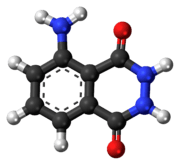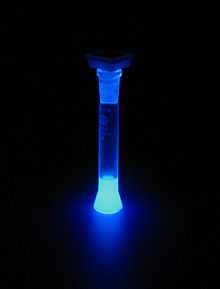Luminol
 | |
 | |
| Names | |
|---|---|
| IUPAC names
5-Amino-2,3-dihydro- 1,4-phthalazinedione | |
| Other names
o-Aminophthaloyl hydrazide o-Aminophthalyl hydrazide 3-Aminophthalhydrazide 3-Aminophthalic hydrazide | |
| Identifiers | |
| 521-31-3 | |
| ChEMBL | ChEMBL442329 |
| ChemSpider | 10192 |
| EC number | 208-309-4 |
| |
| Jmol-3D images | Image |
| PubChem | 10638 |
| |
| Properties | |
| C8H7N3O2 | |
| Molar mass | 177.16 g/mol |
| Melting point | 319 °C (606 °F; 592 K) |
| Hazards | |
| MSDS | MSDS for luminol |
| NFPA 704 | |
| Except where noted otherwise, data is given for materials in their standard state (at 25 °C (77 °F), 100 kPa) | |
| | |
| Infobox references | |
Luminol (C8H7N3O2) is a versatile chemical that exhibits chemiluminescence, with a striking blue glow, when mixed with an appropriate oxidizing agent. Luminol is a white-to-pale-yellow crystalline solid that is soluble in most polar organic solvents but is insoluble in water.
Luminol is used by forensic investigators to detect trace amounts of blood left at crime scenes, as it reacts with iron found in hemoglobin. It is used by biologists in cellular assays for the detection of copper, iron, and cyanides, as well as of specific proteins by western blot.
Luminol can be sprayed evenly across the area, and trace amounts of an activating oxidant will cause the luminol to emit a blue glow that can be seen in a darkened room. The glow lasts for about 30 seconds, but the effect can be documented by a long-exposure photograph. It is important that the spraying be evenly applied to avoid a biased impression, such as blood traces appearing to be more concentrated in areas that received more spray. The intensity of the glow does not indicate the original amount present but indicates only the distribution of trace amounts of substances left in the area.
Synthesis
Luminol may be synthesized by a reverse-phosphorescence, two-step process. It begins from 3-nitrophthalic acid.[2][3] First, hydrazine (N2H4) is heated with the 3-nitrophthalic acid in a high-boiling solvent such as triethylene glycol. An acyl substitution condensation reaction occurs, with loss of water, forming 3-nitrophthalhydrazide. Reduction of the nitro group to an amino group with sodium dithionite (Na2S2O4), via a transient hydroxylamine intermediate, produces luminol.

Luminol was first synthesized in Germany in 1902,[4] but the compound was not named "luminol" until 1934.[2][5]
Chemiluminescence

To exhibit its luminescence, the luminol must be activated with an oxidant. Usually, a solution containing hydrogen peroxide (H2O2) and hydroxide ions in water is used as the activator. In the presence of a catalyst such as an iron or periodate compound, the hydrogen peroxide is decomposed to form oxygen and water:
- 2 H2O2 → O2 + 2 H2O
- H2O2 + KIO4 → KIO3 + O2 + H2O
In a laboratory setting, the catalyst used is often potassium ferricyanide or potassium periodate. In the forensic detection of blood, the catalyst is the iron present in hemoglobin.[6] Enzymes in a variety of biological systems may also catalyze the decomposition of hydrogen peroxide.
When luminol reacts with the hydroxide ion, a dianion is formed. The oxygen produced from the hydrogen peroxide then reacts with the luminol dianion. The product of this reaction, an organic peroxide, is very unstable and is made by the loss of a nitrogen molecule, the change of electrons from excited state to ground state, and the emission of energy as a photon. This emission produces the blue glow.

Use by crime scene investigators
History
In 1928, the German chemist H. O. Albrecht found that blood, among other substances, enhanced the luminescence of luminol in an alkaline solution of hydrogen peroxide.[7][8] In 1936, Karl Gleu and Karl Pfannstiel confirmed this enhancement in the presence of hematin, a component of blood.[9] In 1937, the German forensic scientist Walter Specht made extensive studies of luminol's application to the detection of blood at crime scenes.[10] In 1939, Proescher and Moody made three important observations with Luminol: 1. Although the test is presumptive, large areas of suspected material can be examined rapidly, 2. dried and decomposed blood gave a stronger and more lasting reaction than fresh blood, 3. If the luminescence disappears, it may be reproduced by the application of a fresh luminol-hydrogen peroxide solution; dried bloodstains may thus be made luminescent many times over[11]
Theory
Luminol is used by crime scene investigators to locate traces of blood, even if it has been cleaned or removed. The investigator sprays a solution of luminol and the oxidant. The iron present in blood catalyzes the luminescence. The amount of catalyst necessary for the reaction to occur is very small relative to the amount of luminol, allowing the detection of even trace amounts of blood. The blue glow lasts for about 30 seconds. Detecting the glow requires a fairly dark room. Any glow detected may be documented by a long-exposure photograph.
Drawbacks
Luminol has some drawbacks that may limit its use in a crime scene investigation:
- Luminol chemiluminescence can also be triggered by a number of substances such as copper or copper-containing chemical compounds,[12] and certain bleaches; and, as a result, if a crime scene is thoroughly cleaned with a bleach solution, residual cleaner will cause the entire crime scene to produce the typical blue glow, effectively camouflaging any organic evidence, such as blood.
- Horseradish sauce, via the enzyme horseradish peroxidase, catalyses the oxidation of luminol, emitting light at 428 nm (blue in the visible spectrum), which may result in a false positive.
- Luminol will also detect the small amounts of blood present in urine, and it can be distorted if animal blood is present in the room that is being tested.
- Luminol reacts with fecal matter, causing the same glow as if it were blood.
- Luminol's presence may prevent other tests from being performed on a piece of evidence. However, it has been shown that DNA can be successfully extracted from samples treated with luminol reagent.[13]
- excessive smoke in a enclosed space can result in positive results with Luminol. For example, an excessive cigarette smoker who smokes in his or her vehicle.[11]
Related molecules
- Luminol: 5-amino-2,3-dihydro-1,4-phthalazinedione ; 3-amino-phthalhydrazide ; 1,4-phthalazinedione, 5-amino-2,3-dihydro ; CAS: [521-31-3]
C8H7N3O2 — MW: 177.16
λabs (in 0.1 N NaOH) λmax 1 : 347 nm & λmax 2 : 300 nm; EC (at λmax 1): 7650 L/mol × cm
λabs / λem (MetOH): 355/413 nm - Luminol, hemihydrate: 3-amino-phthalhydrazide Na salt; CAS: [206658-90-4]
C8H6N3O2Na · 1⁄2H2O — MW: 217.16 - Luminol, Na salt: 3-amino-phthalhydrazide Na salt; CAS: [20666-12-0]
C8H6N3O2Na — MW: 199.12 - Luminol, HCl: 3-amino-phthalhydrazide HydroChloride; CAS: [74165-64-3]
C8H7N3O2 · HCl — MW: 213.62 - Isoluminol: 4-aminophthalhydrazide; CAS: [3682-14-1]
C8H7N3O2 – MW: 117.16 (Xi) - Isoluminol, monohydrate: 4-aminophthalhydrazide monohydrate
C8H7N3O2 · H2O — MW: 195.15 - Isoluminol ABEI: 4-aminophthalhydrazide monohydrate; CAS: [66612-29-1]
See also
References
- ↑ Merck Index, 11th Edition, 5470.
- ↑ 2.0 2.1 Ernest Huntress, Lester Stanley, Almon Parker (1934). "The preparation of 3-aminophthalhydrazide for use in the demonstration of chemiluminescence". Journal of the American Chemical Society 56 (1): 241–242. doi:10.1021/ja01316a077.
- ↑ Synthesis of luminol
- ↑ See:
- Aloys Josef Schmitz, "Ueber das Hydrazid der Trimesinsäure und der Hemimellithsäure" (On the hydrazide of trimesic acid [1,3,5-benzenetricarboxylic acid] and of hemimellitic acid [1,2,3-benzenetricarboxylic acid]), Inaugural Dissertation, Heidelberg University, 1902; see pages 17 and 39-43. Schmitz calls luminol "1-amino-2,3-phtalsäurehydrazid".
- Note: Gill states that luminol was prepared as early as 1853. See: Steven K. Gill (1983) "New developments in chemiluminescence research," Aldrichimica Acta 16 (3) : 59-61; see footnote 2 on page 60. Available at: Aldrichimica Acta. However, the sources that are cited by Gill don't mention the preparation of luminol before 1902. Gill probably confused luminol with "lophine" (2,4,5-triphenyl-1H -imidazole), which is mentioned in the sources that Gill cites, and which is also chemiluminescent, and which was first prepared in 1844 by Auguste Laurent. (See: Auguste Laurent (1844) "Sur un nouvel alcali organique, la lophine" (On a new organic alkali, lophine), Revue scientifique et industrielle, 18: 272-278.) The chemiluminescence of lophine was first observed by: Radziszewski, Bronisław L. (1877) "Untersuchungen über Hydrobenzamid, Amarin und Lophin" (Investigations of hydrobenzamide, amarine, and lophine), Berichte der Deutschen chemischen Gesellschaft zu Berlin, 10 : 70-75. In 1853, Ludwig Teichmann developed a test for blood, but it did not rely on chemiluminescence. See: L Teichmann (1853) "Ueber die Krystallisation der organischen Bestandtheile des Bluts" (On the crystallization of the organic components of blood), Zeitschrift für rationelle Medicin, new series, 3 : 375-388.
- ↑ See also: Ernest H. Huntress, Lester N. Stanley, and Almon S. Parker (March 1934) "The oxidation of 3-aminophthalhydrazide ("luminol") as a lecture demonstration of chemiluminescence," Journal of Chemical Education, 11 (3) : 142-145.
- ↑ Ples, Marek. "Chemiluminescence activated by blood". www.weirdscience.eu (in Polish). Retrieved 2014-12-23.
- ↑ H. O. Albrecht (1928) "Über die Chemiluminescenz des Aminophthalsäurehydrazids" (On the chemiluminescence of aminophthalic acid hydrazide) Zeitschrift für Physikalische Chemie 136: 321-330.
- ↑ Stuart H. James and William G. Eckert, Interpretation of Bloodstain Evidence at Crime Scenes, 2nd ed. (Boca Raton, Florida: CRC Press LLC, 1998), page 154.
- ↑ Gleu, Karl ; Pfannstiel, Karl (1936) "Über 3-aminophthalsaure-hydrazid" Journal für Praktische Chemie 146: 137-150.
- ↑ Specht, Walter (1937) "Die Chemiluminescenz des Hämins, ein Hilfsmittel zur Auffindung und Erkennung forensisch wichtiger Blutspuren" (The chemiluminescence of haemin, an aid to the finding and recognition of forensically significant blood traces), Angewandte Chemie 50 (8): 155-157.
- ↑ 11.0 11.1 James, Stuart; Kish, Paul E.; Sutton, Paulette Sutton (2005). Principles of Bloodstsain Pattern Analysis. Boca Raton, London, New York, Singapore: Taylor and Francis Group. p. 376. ISBN 0-8493-2014-3.
- ↑ Ples, Marek. "Chemiluminescence of luminol activated by copper compound". www.weirdscience.eu (in Polish). Retrieved 2014-12-23.
- ↑ Technical note about Hemaglow
External links
| Wikimedia Commons has media related to Luminol. |
